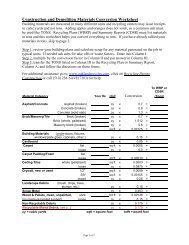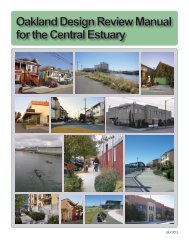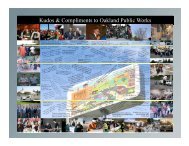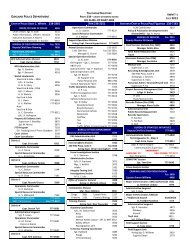Intelligent Transportation Systems - City of Oakland
Intelligent Transportation Systems - City of Oakland
Intelligent Transportation Systems - City of Oakland
Create successful ePaper yourself
Turn your PDF publications into a flip-book with our unique Google optimized e-Paper software.
the downtown area) is time-based. Due to this lack <strong>of</strong> centralized control, it is necessary<br />
to go into the field to assess signal problems when they occur instead <strong>of</strong> having the<br />
advantage <strong>of</strong> instantly obtaining timing information on a central computer. Then, after<br />
traffic engineers optimize signal timings in the <strong>of</strong>fice it is necessary for personnel to go<br />
back into the field and upload the timings manually. To address these inefficiencies the<br />
<strong>City</strong> <strong>of</strong> <strong>Oakland</strong> has long expressed interest in a centralized, real-time signal control<br />
system which will allow traffic staff to both respond to events immediately, and to<br />
constantly monitor the system.<br />
The emergency operations center (EOC) in downtown <strong>Oakland</strong> is not currently<br />
integrated with any <strong>of</strong> the signals, but the need to integrate the EOC with a central signal<br />
control system was expressed by <strong>City</strong> staff. The EOC already has automatic vehicle<br />
location (AVL) capabilities with its emergency vehicles, and plans to implement<br />
computer aided dispatch (CAD) capabilities within 18 months <strong>of</strong> this report.<br />
In 1994 DKS Associates assisted <strong>Oakland</strong> in studying a central computerized traffic<br />
control system, initially to manage 21 signals in the downtown area (referred to as the<br />
North CBD) plus 16 signals in the Hegenberger/73 rd Avenue corridor. The report<br />
distinguishes between distributed control systems (which store and implement signal<br />
timing plans in traffic signal controllers) and central control systems (which store and<br />
implement signal timing plans from a central computer).<br />
Based on the results <strong>of</strong> that evaluation, it was determined that central control signal<br />
systems would be good candidates for the <strong>City</strong> <strong>of</strong> <strong>Oakland</strong>. The systems studied<br />
(namely MIST, Series 2000, MONARC, TMS, UTCS and IVMS) were scalable and<br />
would give <strong>Oakland</strong> the capability to operate large and eventually citywide coordinated<br />
systems. It was emphasized that all controllers should be standardized to the same type<br />
to facilitate coordination, allow interchangeability, and avoid extra training and parts<br />
replacement. At the time <strong>of</strong> that report (1994) it was recommended that the <strong>City</strong><br />
purchase a central master computer traffic control system, the MIST traffic signal<br />
system, in order to retain the <strong>City</strong>’s existing controllers without modifications. Because<br />
no central signal control system was implemented at that time, these previous<br />
recommendations to the <strong>City</strong> will be revisited as part <strong>of</strong> this citywide ITS Strategic Plan.<br />
Changes in the ITS industry (pertaining to technologies and costs), new <strong>City</strong> projects,<br />
and changes in the <strong>City</strong>’s growth and traffic operations will necessitate more up-to-date<br />
recommendations.<br />
2.2.2 Traffic Signal Controllers<br />
As described in Section 2.2, the <strong>City</strong> has approximately 700 signals. These signals are<br />
illustrated in Figure 2.1. The current signal inventory was obtained from Metropolitan<br />
<strong>Transportation</strong> Commission’s (MTC’s) Signals Database as well as from discussions<br />
with <strong>City</strong> staff, and is listed for reference in Appendix B. As shown in Figure 2.1, most<br />
<strong>of</strong> the signals are concentrated along the high-priority corridors described in Section<br />
2.1.2, reflecting the <strong>City</strong> corridors pinpointed in <strong>Oakland</strong>’s General Plan.<br />
<strong>City</strong> <strong>of</strong> <strong>Oakland</strong> ITS Strategic Plan<br />
9 September, 2003
















